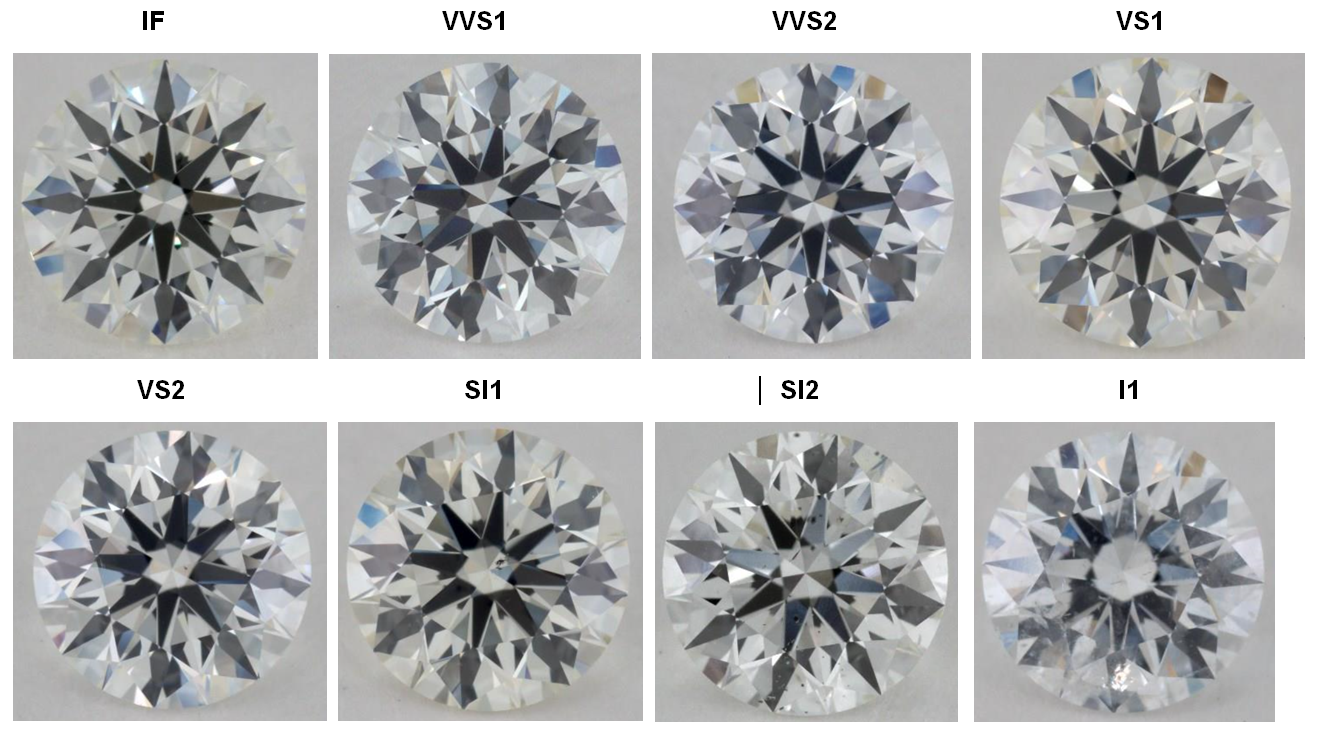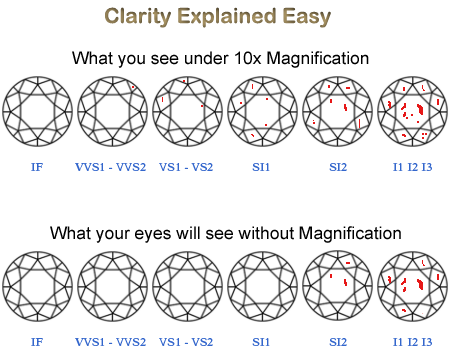Quick & Easy Diamond Series: GIA Diamond Clarity
- Posted on
- By Freedman Jewelers
- Posted in Diamond Clarity, Diamonds, GIA Diamond
Hello! Welcome to the second part of our Quick and Easy Diamond Series, where we’re giving you straightforward advice and quick tips about buying diamonds and The 4 C’s.
Here at Freedman Jewelers, we understand that figuring out how to buy an engagement ring can be stressful and overwhelming. You take one look at the GIA grading scales, and none of it makes logical sense at first. There are letters, mixed with numbers, and they’re not even in alphabetical order! On top of that, you are working on a strict budget, and you’re not even sure what that budget will get you. But you want to give the love of your life the ring of her dreams. No pressure, right?
So seriously, we get it! And we’re here to help.
If you missed the first post in this series, we recommend starting there, as it will be your guide in determining what GIA color grade you should be looking at given your ring and your budget - which is a good place to begin.
Here, we’ll provide an overview on diamond clarity and their GIA grading scale. Plus, we’ll give you specific advice about which clarity grade you should stick to when looking at diamonds based on your ring and your budget.
DIAMOND CLARITY:
Clarity can seem like the most confusing of the 4 C’s when you first start learning about diamonds. But in reality, as you’ll learn in this post, once you understand the basics of the grading scale, it’s fairly easy to narrow down the right grade range for you. Beyond that, you can use the help of a diamond expert, like one of our team here at Freedman Jewelers, to explain specific and nitty-gritty details about each individual stone.
OVERVIEW:
To put it simply, a diamond’s clarity refers to any inclusions and blemishes it has. An inclusion is a broad term to describe a flaw existing on the inside of a diamond. A blemish is a broad term to describe a flaw existing on the outside surface of the stone.
Within each of these groups, there is a list of specific types of flaws. Whether it’s a nick on the inside, a chip on the outside or a cloudy spot underneath, each flaw has a term. A diamond with more flaws will make it hard for light to pass through the diamond, negatively impacting the brilliance or sparkle of the stone. In some cases, it can create dark spots or blurry areas in a stone, that aren’t as visually appealing as a clearer stone. Some flaws are more obvious and effect the beauty and the value of a diamond more than others. But size and location of the flaws are equally as important.
The GIA grades a diamond’s clarity based on the presence and visibility of its flaws. As a certified GIA gemologist assesses the clarity of each diamond through a 10x loupe, they create a “diamond plotting diagram” (also referred to as it’s “plot chart”) which is a series of drawings that resemble the shape of the diamond and it’s view from the top and the bottom, as well as its’ facet arrangement and specific markings for each and every inclusion that they see.
These plotting diagrams, which are included in the diamond’s GIA certificate, allow you to understand what and where each identifying feature is located on the diamond, and why it was given its clarity grading (as well as others). Here’s an example of a diamond plotting diagram for a round diamond:

Instead of getting into the nitty gritty details of each plotting diagram symbol (though we will do that at a later date), we want to help you determine what clarity gradings you should be looking at for your engagement ring’s diamond. Narrowing it down to a specific range will make the diamond process easier and faster for you.
So, first use the information below to nail down your clarity range. Then plan to meet with a diamond expert to discuss any specific inclusions and the diamond plot for any specific stone you consider buying.
UNDERSTANDING THE CLARITY SCALE

The two highest GIA clarity gradings for diamonds are ‘flawless’ and ‘internally flawless.’ You won’t likely be seeing any of these in your engagement ring search as only the rarest diamonds are rated so high. Plus, even when budget it is a non-issue, it’s unusual for a diamond buyer to spend their money on a diamond of this quality.
So, when thinking specifically about your engagement ring, think about the clarity scale as one that ranges from VVS1 through I3. And don’t worry, it’s not as random as it sounds.

Here’s a letter key to help you understand the scale:
V = Very
S = Slightly
I = Included
1 = Better
2 = Worse
The key above can be used to interpret the meaning of any GIA clarity grade. For example, a VS1 means the diamond is on the better end of “Very Slightly” included. An SI2 is on the worse end of “Slightly Included.”
Below are a handful of plotting diagrams in order of their GIA clarity grading (both with and without a 10x magnification), to give you a sense of how many flaws a diamond of each grade might have, as well as where they might be located:

OVERALL FREEDMAN RECOMMENDATION:
As always, there’s no real right or wrong answer when it comes to choosing your diamond. That said, we understand the need for straightforward recommendations sometimes. And unless there is no limit to your budget, it’s likely you’re working to find the right balance between the cost and quality of your diamond.
So, when it comes to diamond clarity, here is our overall Freedman Jewelers Recommendation:
Choose a diamond with a clarity grade in the VS1-SI1 range if your budget will allow it. Anything higher than a VS1 won’t likely make a noticeable enough difference to make it worth the significantly higher cost. And anything lower than an SI1 may risk too much sparkle and beauty due to the number and location of its flaws.
On occasion, there are SI2 diamonds that are perfectly fine for our client’s engagement rings. However, if you are looking to save with an SI2 clarity grade, we recommend allowing one of our Freedman diamond experts help you pick and assess a handful of SI2 stones.
Here’s why: In 80-90% of SI2 diamonds, inclusions will be visible with the naked eye. However, here at Freedman Jewelers, we only keep SI2 stones that are “eye clean,” meaning their inclusions are not visible with the naked eye. In other words, at Freedman Jewelers, you’ll only find the best 10-20% of SI2 diamonds available.
What’s the difference?
To get a sense of how GIA clarity grades affect the look of a diamond, check out the image below. It demonstrates the visible difference between a VS1 and a SI2 clarity grade. As you can see, the flaws and inclusions in the SI2 are far more visible than they are in the VS1.
That said, be mindful that the comparison here is rather exaggerated given that a photo can’t reflect light, so the inclusions aren’t masked and hidden by the sparkle the diamonds would exhibit in real life.

OTHER FREEDMAN RECOMMENDATIONS:
Here are some more specific recommendations based on your future engagement ring style, setting, and intended cost:
DIAMOND SHAPE:
When deciding which GIA clarity grade is right for you, be sure to factor in the shape of the diamond you’re buying. Some shapes are more transparent than others and reflect light differently, so the clarity of the stone becomes more important in it’s overall appearance.

Round, Cushion, Princess Cut: Because of the many facets (or cuts) made in creating round, cushion, and even princess cut diamonds, they’ll naturally reflect more light and create more sparkle compared to some of the other diamond shapes. Thanks to that sparkle, internal and external flaws will likely be less noticeable to the naked eye. And in some cases, they’ll have less of a negative effect on the appearance the stones.
So, if budget is your top priority and you’re looking for ways to save on a round, cushion or princess cut diamond, you may want to look into stones with a VS2 or SI1 clarity grade. In some cases, you can even find suitable stones with an SI2 grade.
Keep in mind: While the sparkle of brilliant cut diamonds may create more flexibility in clarity, it does not necessarily mean you will want to compromise in this area. In fact, some clients find that the clarity of a diamond is the most important after seeing diamonds in person and choose to sacrifice elsewhere, regardless of the shape.
Emerald, Asscher:
Unlike brilliant cut diamonds like rounds and cushions, emerald and asscher diamonds have what’s called “step cut” facets, meaning they are more see-through than they are sparkling, much like a hall of mirrors. In other words, they create a straight portal into the diamond.
Because of the open visibility into these diamonds, we don’t recommend compromising as much on the clarity grading when buying one of these shapes. Instead of sparkle masking the flaws like in a brilliant stone, the mirroring reflections of light make them more noticeable (as seen in the image below). Additionally, sharpness and transparency are their most attractive quality, so usually, the higher the clarity the better.
So, if you’re interested in buying an emerald, asscher or other step-cut stone, we recommend choosing VS2 grade or higher, if you can.

Oval, marquise, pear:
While not as commonly chosen for engagement rings compared to some other shapes, ovals, marquises, and pear cuts are cousins to the other brilliant cut diamonds (round, cushion, princess). They, too, have many facets so they’re loved for their extra sparkle.
That said, because these diamonds tend to be shallower in their table and have a wider surface area in some places, the clarity of oval, marquise, and pear cut diamonds becomes slightly more important. So if you’re considering one of these shapes, we recommend choosing a GIA clarity grade of at least SI1 (unless an Freedman expert has given an SI2 a stamp of approval).
SETTINGS:
 Solitaire: A solitaire setting is one of the most timeless and beautiful choices when it comes to diamond engagement rings. If this is the style you’re looking for, we recommend choosing the highest GIA gradings that your budget can afford, including in clarity.
Solitaire: A solitaire setting is one of the most timeless and beautiful choices when it comes to diamond engagement rings. If this is the style you’re looking for, we recommend choosing the highest GIA gradings that your budget can afford, including in clarity.
Here’s why: A diamond is the center focus of a solitaire engagement ring, whereas other more intricate settings can mask or distract the eye from inclusions in a lower quality stone. So in the case of solitaire rings, we recommend a clarity grade of at least SI1, but preferably a VI2 or higher.
Halo: A halo engagement ring setting can both enhance the sparkle of an engagement ring, while also masking some of the flaws in its clarity and color. So with settings like these, you may have more room to compromise on the GIA clarity grading. Depending on the size and specific style of the halo setting, we tell our clients who are trying to save in cost that they can consider diamonds with SI1 and SI2 clarity grades.
 Again, while you can compromise here, you may find that a higher clarity grade is worth the additional cost to you once you see a diamond in person. So before settling on an SI1 before seeing any in person, we do suggest checking out a few different diamonds with different grades to get a sense for what feels best to you. Remember, every diamond is different - even if they have the same GIA grades!
Again, while you can compromise here, you may find that a higher clarity grade is worth the additional cost to you once you see a diamond in person. So before settling on an SI1 before seeing any in person, we do suggest checking out a few different diamonds with different grades to get a sense for what feels best to you. Remember, every diamond is different - even if they have the same GIA grades!
Quick Tip: Once you’ve picked out a diamond, ask your jeweler to try and position it within its setting so that the inclusions are hidden under the prongs or in a way where they may be less obvious.
METAL:
Simply put, the metal of an engagement ring (including platinum, yellow gold or white gold) will not have any positive or negative effect on the clarity of your diamond. So check this factor off your list!
OUR BEST ADVICE:
Regardless of your diamond shape, setting, or budget, seeing diamonds in person is paramount when it comes to clarity. Why?

1. Diamond plotting graphs can be misleading. While the GIA does a great job assessing each stone and providing details in their certificates, their plotting graphs can be misleading if you’re looking at it without the stone in person. For example, you might find that one plot is speckled with all sorts of marks and lines, and another only one or two.
In this case, you’ll likely assume that the stone with more marks has poorer clarity and is, therefore, less beautiful. However, it’s not uncommon that a diamond with a handful of small inclusions is actually more pure looking than a diamond with only one or two inclusions that are bigger in size and more visible to the naked eye.This means you can’t make assumptions about the appearance of a diamond based on its plotting graph. And while the diamond plotting graphs are helpful in learning every detail about a stone, you can’t really know how a diamond’s flaws or inclusions effect it’s clarity and sparkle unless you see it in person.
2. You really need a loupe. Generally speaking, you really shouldn’t buy a diamond without seeing it through a 10x loupe, particularly when assessing the clarity of a stone. This, of course, must be done in person.
3. Sometimes the only noticeable difference is in price. There’s no arguing that, if all other GIA grades are the same, a VS1 is going to be more expensive than a SI1. However, what many diamond shoppers don’t know is that while a VS1 will always be more expensive, it may not always be more visibly pure looking. In fact, sometimes, it’s nearly impossible to see the difference between two diamonds with neighboring GIA clarity grades. This is just one more reason it’s vital to look at diamonds in person, especially for those searching for the perfect ring on a tight budget.
CONCLUSION:
While at first, it may seem like a diamond is a diamond, and you barely notice the difference between clarity or color grades, the truth is that the slight differences do matter. Here’s why: Diamonds are an expression of your love. And if there is ever a time prioritize this kind of expression, it’s with your engagement ring when you propose. And while you may not see the difference, she’ll know it and appreciate the
So take your time to examine the stones in person and meet with a Freedman expert to talk about what diamond makes the most sense. Trust us, after one visit, you’ll feel far less overwhelmed and much more confident in what diamond is best for you.

In fact, Freedman Jewelers inspects every single diamond before adding them to their inventory, in order that their customers only ever see the best ones. This includes the clarity grades! For example, when you look at diamonds here at Freedman Jewelers, you’ll see the best of the best of SI1s and the best of the best SI2s. This means the price will be equally as affordable as shopping elsewhere and online, but the quality of the diamonds will be higher.
Quick tip: If the quality or clarity of a diamond looks too good for the price being offered, the reality is that the diamond probably should have been given a lower GIA clarity grading, and it was a borderline call. So be wary of diamond deals that look too good to be true.
Still worried? Not sure what to do? Give us a call. We’ll walk you through the entire diamond process and show you individual stones until you find one that fits your budget and your dream ring. If you aren’t sure which diamonds or rings to ask about, feel free to let us take the lead. Just give us an idea of how much you'd like to spend, and we’ll show you a handful of diamonds and rings to match that budget. And we'll teach you along the way!
No matter how you start, just get excited about it. We're committed to making it comfortable, fun, and stress-free...From cut, to color, to clarity!
Until Next Time,
The Freedman Team
